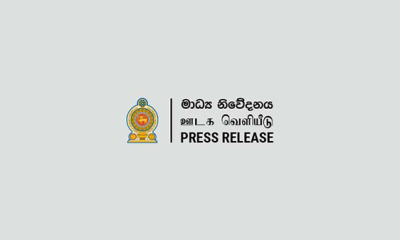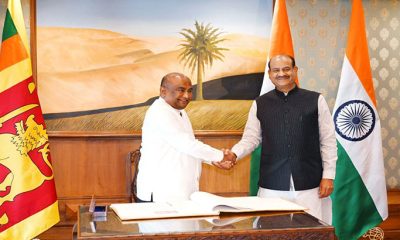Features
Pros and cons of loans on lines of credit

by Neville Ladduwahetty
An MP is reported to have claimed that several types of vegetables and yams have been imported at a cost of $293 million. Following this disclosure, Minister Mahinda Amaraweera has instructed the Department of Agriculture to investigate the allegation and submit a report.
The country from which vegetables and yams were imported has not been disclosed. Furthermore, although serious attempts have been made and continue to be made to restrict imports to ease pressure on the country’s foreign reserves, the fact remains that items listed in Agreements relating to Lines of Credit continue to be imported despite its impact on local production due to systemic shortcomings. This aspect is reflected with regard to items listed in the Lines of Credit extended by India.
INDIAN LINE of CREDIT
The document of the Ministry of Finance titled “Importation of Essential Items under Indian Credit Facility Operating Guidelines” prepared by the Indian Credit Facility Coordinating Unit (ICFCU) Ministry of Finance Sri Lanka 2022 in its Introduction states:
Introduction
1.” The Government of India has agreed to provide a USD 1,000,000,000 (United States Dollar one billion) credit to the GOSL. Accordingly, a credit facility agreement was signed with the State Bank of India (SBI) to obtain up to an aggregate sum of USD 1 billion for the purpose of importation of essential items from India. This facility will enable registered importers to import essential food items, essential pharmaceuticals and raw materials for local industries from India. The Ministry of Finance together with the Ministry of Trade will take necessary steps to implement this facility.
Once the importers are selected by the Ministry of Trade to import assigned quantities of selected items, they can place orders with the identified Indian suppliers. The importers are required to secure their order by placing a deposit at the General Treasury through their respective banks and once the imports are arrived and cleared by the customs, the Indian suppliers shall be paid with equal Indian Rupees through the SBI.
2. Objectives of the Facility 2.1.1 Cater the demand for essential items. 2.1.2 Supply of essential items in the market without a shortage. 2.1.3 Minimize the pressure on foreign exchange reserves.
SCOPE of ITEMS to be IMPORTED
It is evident from the foregoing that while the Finance Ministry expects to minimize the pressure on foreign exchange, it is the Trade Ministry that identifies the essential items and the supply of these to the market without shortage.
Referring to the Indian Credit Facility a report by the GLOBAL TRADE ALERT identifies the items to be imported and states:
“On 17 March 2022, the State Bank of India signed an agreement with the government of Sri Lanka to provide the latter with a credit facility of USD 1 billion. The credit will be used for the procurement of food, medicine, and other essential commodities. The Indian Finance Minister, Minister of External Affairs, and the Ministry of Finance shared this information on Twitter after the ministers had had a meeting with the Sri Lankan Finance Minister”.
According to some news reports, the credit will be used to procure the above goods from India (see related intervention). The State Bank of India is an Indian government-owned bank.
AGRICULTURAL PRODUCTS IMPORTED as per GLOBAL TRADE ALERT
Cereals; Vegetables; Fruits & nuts; Oilseeds & oleaginous fruits; 015Edible roots & tubers with high starch or inulin content; Stimulant, spice & aromatic crops; Pulses (dried leguminous vegetables); Sugar crops;
Raw milk; Eggs of hens or other birds in shell, fresh Meat & meat products
Prepared & preserved fish, crustaceans, molluscs; Prepared & preserved vegetables, pulses & potatoes; Prepared & preserved fruits & nuts; Animal fats; Vegetable oils; Margarine & similar preparations; Processed liquid milk, cream & whey; Other dairy products; Eggs, in shell, preserved or cooked; Grain mill products; Starches & starch products; sugars & sugar syrups n.e.c; Bakery products; Sugar & molasses; Cocoa, chocolate & sugar confectionery; Macaroni, noodles, couscous & similar farinaceous products; Food products n.e.c.
PROCEDURAL SHORTCOMINGS
Although the Introduction to the Indian Line of Credit states that it is to “import essential food items, essential pharmaceuticals and raw materials for local industries from India”, the task of identifying the items to be imported is left to the “Ministry of Finance together with the Ministry of Trade”.
However, it is the Ministry of Trade under Section 3.2 that “sets out the Committees Established under the Ministry of Trade for this facility a) Main Committee to select importers and Imports 3 b) Subcommittee to provide recommendations to the main committee on essential food items/ animal feed c) Subcommittee to provide recommendations to the main committee on essential pharmaceuticals d) Subcommittee to provide recommendations to the main committee on cement, apparel, special fertilizers and raw material for industries”.
The arrangement under Section 3.2 confirms that the task of identifying the items to be imported it left entirely to the Ministry of Trade. Furthermore, judging from the few sample items cited above by Global Trade Alert relating to Agriculture, it is clearly evident that Ministry of Trade has determined the items to be imported from India without consulting the interests of affected Ministries such as Agriculture, Health, Tourism etc.
In such a context the assurance given by the Minister of Agriculture to the Sri Lankan farmers that “the Government would not approve the import of any vegetables that can be grown in Sri Lanka”, should have been directed to the Ministry of Trade and not to the farmers. The unilateral action taken by the Ministry of Trade undermines not only the interests of local producers of agricultural products at a moment when Sri Lanka is desperately urging farmers to strengthen their efforts even further, but also sabotages efforts towards food security.
Under provisions of Section 4 “Implementation Mechanism”, once the ICFCU sends the supplier’s approved “Performa Invoice” to the Importer’s Bank, that Bank is expected to open an LC in INR with the Standard Bank of India (SBI). Therefore, according to the procedure stated above, if on arrival the goods fail quarantine clearance the Sri Lankan Importer would lose his deposit to secure his order according to the terms of the Line of Credit.
Had similar clearance criteria existed for items relating to pharmaceutical products that were supplied under the Indian Line of credit and diligently implemented, perhaps the deaths of some and for others to go blind could have been avoided; an issue that prompted the Medical Profession to protest against the quality of some of the medical products delivered under the Indian Line of Credit. Therefore, the agreement should contain provisions to check the quality of the products before they are shipped from India and deposits to secure orders to suppliers made refundable or for payment to the supplier to be withheld until quality assurance and clearance by Customs are completed.
IMPACT of LINES of CREDIT
There is no denying that goods imported from countries such as India and China are cheaper than what is produced locally. Furthermore, payment for goods imported is made in Indian rupees and dollars can be saved.
Their costs are low due to low costs of production, either due to lower wages or higher productivity or a combination of both. Whatever the reason may be, when goods from such countries are imported to countries with higher costs of production, the local producers are seriously disadvantaged because they lose their market share to low priced poorer quality imported products.
This is the case with Sri Lanka. Under such circumstances, the Lines of Credit become attractive mechanisms for countries with low production costs but whose product quality is such that meeting global competition is a challenge, to get rid of their products and win the gratitude and appreciation of countries such as Sri Lanka. This is no different to easing restrictions on imports of items such as tiles that are produced in Sri Lanka.
Therefore, when Lines of Credit on agricultural products that could be grown and processed in Sri Lanka become items to be imported under Lines of Credit from countries such as India, the development of the agricultural sector and its plans for expansion would be seriously impacted. On the other hand, if products that could be grown or produced locally are deleted from items to be imported under Lines of Credit, the government may not be in a position to not only meet the local consumer demands of the nation but to also to deal with the consequences of increase in the cost of living.
Notwithstanding such pros and cons inherent with Lines of Credit, the intention should be to treat them as interim measures with specified time bars, thus giving the local producers incentives and rewards to improve productivity. Therefore, since there is an urgent need to develop the agricultural sector, it is imperative that immediate measures be adopted by the committees and subcommittees appointed under Section 3.2 of the Indian Line of Credit to revise the agricultural products that were to be imported forthwith.
The need for such reviews and revisions apply to other products as well. The objective therefore should be that no item that could be grown, processed or produced in Sri Lanka should be imported from India if Sri Lanka is to not undermine the efforts of Sri Lankan farmers and the aspirations of entrepreneurs engaged in agriculture and overall economic development.
CONCLUSION
Lines of Credit such as those with India should be treated strictly as an interim measure to overcome a temporary crisis situation that Sri Lanka experienced if its long-term national interests are not to be undermined. On the other hand, if it is open ended as reflected with the 2022 Indian Line of Credit, it would be a fetter to ongoing and future economic growth and overall development. This is particularly so in the field of agriculture because it would not only dampen and discourage local efforts of nearly a third of Sri Lanka’s population engaged and committed to the field of agriculture, but also their very livelihoods. Furthermore, it is equally imperative that overall items to be imported under Lines of Credit be identified in a manner that does not hamper overall long-term growth plans.
Judging from the items listed by Global Trade Alert in respect of agricultural products to be imported as determined by the Committees and Subcommittees set up under Section 3.2 in the Indian Line of Credit, they appear to have been guided ONLY by the compulsion to meet demand without shortage. The fact that such narrow perspectives undermine the agendas of the Ministry of Agriculture does not appear to have occurred to the Ministry of Trade.
Equally, the Ministry of Finance has not realised any need for coordination between affected Ministries. What is starkly evident is the tendency for each Ministry to operate strictly within its respective domain regardless of the negative impact of such an attitude on the development plans of other Ministries.
Therefore, there is an urgent need to revisit the Indian Line of Credit developed in 2022 and to set up a coordinating body to identify the items to be imported including the relevant procedures if the national interests and development plans are to be protected. Such coordination should apply to other areas of economic activity as well. Failure to do so would amount to repaying another loan without an appropriate return to the country.
Features
The heart-friendly health minister

by Dr Gotabhya Ranasinghe
Senior Consultant Cardiologist
National Hospital Sri Lanka
When we sought a meeting with Hon Dr. Ramesh Pathirana, Minister of Health, he graciously cleared his busy schedule to accommodate us. Renowned for his attentive listening and deep understanding, Minister Pathirana is dedicated to advancing the health sector. His openness and transparency exemplify the qualities of an exemplary politician and minister.
Dr. Palitha Mahipala, the current Health Secretary, demonstrates both commendable enthusiasm and unwavering support. This combination of attributes makes him a highly compatible colleague for the esteemed Minister of Health.
Our discussion centered on a project that has been in the works for the past 30 years, one that no other minister had managed to advance.
Minister Pathirana, however, recognized the project’s significance and its potential to revolutionize care for heart patients.
The project involves the construction of a state-of-the-art facility at the premises of the National Hospital Colombo. The project’s location within the premises of the National Hospital underscores its importance and relevance to the healthcare infrastructure of the nation.
This facility will include a cardiology building and a tertiary care center, equipped with the latest technology to handle and treat all types of heart-related conditions and surgeries.
Securing funding was a major milestone for this initiative. Minister Pathirana successfully obtained approval for a $40 billion loan from the Asian Development Bank. With the funding in place, the foundation stone is scheduled to be laid in September this year, and construction will begin in January 2025.
This project guarantees a consistent and uninterrupted supply of stents and related medications for heart patients. As a result, patients will have timely access to essential medical supplies during their treatment and recovery. By securing these critical resources, the project aims to enhance patient outcomes, minimize treatment delays, and maintain the highest standards of cardiac care.
Upon its fruition, this monumental building will serve as a beacon of hope and healing, symbolizing the unwavering dedication to improving patient outcomes and fostering a healthier society.We anticipate a future marked by significant progress and positive outcomes in Sri Lanka’s cardiovascular treatment landscape within the foreseeable timeframe.
Features
A LOVING TRIBUTE TO JESUIT FR. ALOYSIUS PIERIS ON HIS 90th BIRTHDAY

by Fr. Emmanuel Fernando, OMI
Jesuit Fr. Aloysius Pieris (affectionately called Fr. Aloy) celebrated his 90th birthday on April 9, 2024 and I, as the editor of our Oblate Journal, THE MISSIONARY OBLATE had gone to press by that time. Immediately I decided to publish an article, appreciating the untiring selfless services he continues to offer for inter-Faith dialogue, the renewal of the Catholic Church, his concern for the poor and the suffering Sri Lankan masses and to me, the present writer.
It was in 1988, when I was appointed Director of the Oblate Scholastics at Ampitiya by the then Oblate Provincial Fr. Anselm Silva, that I came to know Fr. Aloy more closely. Knowing well his expertise in matters spiritual, theological, Indological and pastoral, and with the collaborative spirit of my companion-formators, our Oblate Scholastics were sent to Tulana, the Research and Encounter Centre, Kelaniya, of which he is the Founder-Director, for ‘exposure-programmes’ on matters spiritual, biblical, theological and pastoral. Some of these dimensions according to my view and that of my companion-formators, were not available at the National Seminary, Ampitiya.
Ever since that time, our Oblate formators/ accompaniers at the Oblate Scholasticate, Ampitiya , have continued to send our Oblate Scholastics to Tulana Centre for deepening their insights and convictions regarding matters needed to serve the people in today’s context. Fr. Aloy also had tried very enthusiastically with the Oblate team headed by Frs. Oswald Firth and Clement Waidyasekara to begin a Theologate, directed by the Religious Congregations in Sri Lanka, for the contextual formation/ accompaniment of their members. It should very well be a desired goal of the Leaders / Provincials of the Religious Congregations.
Besides being a formator/accompanier at the Oblate Scholasticate, I was entrusted also with the task of editing and publishing our Oblate journal, ‘The Missionary Oblate’. To maintain the quality of the journal I continue to depend on Fr. Aloy for his thought-provoking and stimulating articles on Biblical Spirituality, Biblical Theology and Ecclesiology. I am very grateful to him for his generous assistance. Of late, his writings on renewal of the Church, initiated by Pope St. John XX111 and continued by Pope Francis through the Synodal path, published in our Oblate journal, enable our readers to focus their attention also on the needed renewal in the Catholic Church in Sri Lanka. Fr. Aloy appreciated very much the Synodal path adopted by the Jesuit Pope Francis for the renewal of the Church, rooted very much on prayerful discernment. In my Religious and presbyteral life, Fr.Aloy continues to be my spiritual animator / guide and ongoing formator / acccompanier.
Fr. Aloysius Pieris, BA Hons (Lond), LPh (SHC, India), STL (PFT, Naples), PhD (SLU/VC), ThD (Tilburg), D.Ltt (KU), has been one of the eminent Asian theologians well recognized internationally and one who has lectured and held visiting chairs in many universities both in the West and in the East. Many members of Religious Congregations from Asian countries have benefited from his lectures and guidance in the East Asian Pastoral Institute (EAPI) in Manila, Philippines. He had been a Theologian consulted by the Federation of Asian Bishops’ Conferences for many years. During his professorship at the Gregorian University in Rome, he was called to be a member of a special group of advisers on other religions consulted by Pope Paul VI.
Fr. Aloy is the author of more than 30 books and well over 500 Research Papers. Some of his books and articles have been translated and published in several countries. Among those books, one can find the following: 1) The Genesis of an Asian Theology of Liberation (An Autobiographical Excursus on the Art of Theologising in Asia, 2) An Asian Theology of Liberation, 3) Providential Timeliness of Vatican 11 (a long-overdue halt to a scandalous millennium, 4) Give Vatican 11 a chance, 5) Leadership in the Church, 6) Relishing our faith in working for justice (Themes for study and discussion), 7) A Message meant mainly, not exclusively for Jesuits (Background information necessary for helping Francis renew the Church), 8) Lent in Lanka (Reflections and Resolutions, 9) Love meets wisdom (A Christian Experience of Buddhism, 10) Fire and Water 11) God’s Reign for God’s poor, 12) Our Unhiddden Agenda (How we Jesuits work, pray and form our men). He is also the Editor of two journals, Vagdevi, Journal of Religious Reflection and Dialogue, New Series.
Fr. Aloy has a BA in Pali and Sanskrit from the University of London and a Ph.D in Buddhist Philosophy from the University of Sri Lankan, Vidyodaya Campus. On Nov. 23, 2019, he was awarded the prestigious honorary Doctorate of Literature (D.Litt) by the Chancellor of the University of Kelaniya, the Most Venerable Welamitiyawe Dharmakirthi Sri Kusala Dhamma Thera.
Fr. Aloy continues to be a promoter of Gospel values and virtues. Justice as a constitutive dimension of love and social concern for the downtrodden masses are very much noted in his life and work. He had very much appreciated the commitment of the late Fr. Joseph (Joe) Fernando, the National Director of the Social and Economic Centre (SEDEC) for the poor.
In Sri Lanka, a few religious Congregations – the Good Shepherd Sisters, the Christian Brothers, the Marist Brothers and the Oblates – have invited him to animate their members especially during their Provincial Congresses, Chapters and International Conferences. The mainline Christian Churches also have sought his advice and followed his seminars. I, for one, regret very much, that the Sri Lankan authorities of the Catholic Church –today’s Hierarchy—- have not sought Fr.
Aloy’s expertise for the renewal of the Catholic Church in Sri Lanka and thus have not benefited from the immense store of wisdom and insight that he can offer to our local Church while the Sri Lankan bishops who governed the Catholic church in the immediate aftermath of the Second Vatican Council (Edmund Fernando OMI, Anthony de Saram, Leo Nanayakkara OSB, Frank Marcus Fernando, Paul Perera,) visited him and consulted him on many matters. Among the Tamil Bishops, Bishop Rayappu Joseph was keeping close contact with him and Bishop J. Deogupillai hosted him and his team visiting him after the horrible Black July massacre of Tamils.
Features
A fairy tale, success or debacle

Sri Lanka-Singapore Free Trade Agreement
By Gomi Senadhira
senadhiragomi@gmail.com
“You might tell fairy tales, but the progress of a country cannot be achieved through such narratives. A country cannot be developed by making false promises. The country moved backward because of the electoral promises made by political parties throughout time. We have witnessed that the ultimate result of this is the country becoming bankrupt. Unfortunately, many segments of the population have not come to realize this yet.” – President Ranil Wickremesinghe, 2024 Budget speech
Any Sri Lankan would agree with the above words of President Wickremesinghe on the false promises our politicians and officials make and the fairy tales they narrate which bankrupted this country. So, to understand this, let’s look at one such fairy tale with lots of false promises; Ranil Wickremesinghe’s greatest achievement in the area of international trade and investment promotion during the Yahapalana period, Sri Lanka-Singapore Free Trade Agreement (SLSFTA).
It is appropriate and timely to do it now as Finance Minister Wickremesinghe has just presented to parliament a bill on the National Policy on Economic Transformation which includes the establishment of an Office for International Trade and the Sri Lanka Institute of Economics and International Trade.
Was SLSFTA a “Cleverly negotiated Free Trade Agreement” as stated by the (former) Minister of Development Strategies and International Trade Malik Samarawickrama during the Parliamentary Debate on the SLSFTA in July 2018, or a colossal blunder covered up with lies, false promises, and fairy tales? After SLSFTA was signed there were a number of fairy tales published on this agreement by the Ministry of Development Strategies and International, Institute of Policy Studies, and others.
However, for this article, I would like to limit my comments to the speech by Minister Samarawickrama during the Parliamentary Debate, and the two most important areas in the agreement which were covered up with lies, fairy tales, and false promises, namely: revenue loss for Sri Lanka and Investment from Singapore. On the other important area, “Waste products dumping” I do not want to comment here as I have written extensively on the issue.
1. The revenue loss
During the Parliamentary Debate in July 2018, Minister Samarawickrama stated “…. let me reiterate that this FTA with Singapore has been very cleverly negotiated by us…. The liberalisation programme under this FTA has been carefully designed to have the least impact on domestic industry and revenue collection. We have included all revenue sensitive items in the negative list of items which will not be subject to removal of tariff. Therefore, 97.8% revenue from Customs duty is protected. Our tariff liberalisation will take place over a period of 12-15 years! In fact, the revenue earned through tariffs on goods imported from Singapore last year was Rs. 35 billion.
The revenue loss for over the next 15 years due to the FTA is only Rs. 733 million– which when annualised, on average, is just Rs. 51 million. That is just 0.14% per year! So anyone who claims the Singapore FTA causes revenue loss to the Government cannot do basic arithmetic! Mr. Speaker, in conclusion, I call on my fellow members of this House – don’t mislead the public with baseless criticism that is not grounded in facts. Don’t look at petty politics and use these issues for your own political survival.”
I was surprised to read the minister’s speech because an article published in January 2018 in “The Straits Times“, based on information released by the Singaporean Negotiators stated, “…. With the FTA, tariff savings for Singapore exports are estimated to hit $10 million annually“.
As the annual tariff savings (that is the revenue loss for Sri Lanka) calculated by the Singaporean Negotiators, Singaporean $ 10 million (Sri Lankan rupees 1,200 million in 2018) was way above the rupees’ 733 million revenue loss for 15 years estimated by the Sri Lankan negotiators, it was clear to any observer that one of the parties to the agreement had not done the basic arithmetic!
Six years later, according to a report published by “The Morning” newspaper, speaking at the Committee on Public Finance (COPF) on 7th May 2024, Mr Samarawickrama’s chief trade negotiator K.J. Weerasinghehad had admitted “…. that forecasted revenue loss for the Government of Sri Lanka through the Singapore FTA is Rs. 450 million in 2023 and Rs. 1.3 billion in 2024.”
If these numbers are correct, as tariff liberalisation under the SLSFTA has just started, we will pass Rs 2 billion very soon. Then, the question is how Sri Lanka’s trade negotiators made such a colossal blunder. Didn’t they do their basic arithmetic? If they didn’t know how to do basic arithmetic they should have at least done their basic readings. For example, the headline of the article published in The Straits Times in January 2018 was “Singapore, Sri Lanka sign FTA, annual savings of $10m expected”.
Anyway, as Sri Lanka’s chief negotiator reiterated at the COPF meeting that “…. since 99% of the tariffs in Singapore have zero rates of duty, Sri Lanka has agreed on 80% tariff liberalisation over a period of 15 years while expecting Singapore investments to address the imbalance in trade,” let’s turn towards investment.
Investment from Singapore
In July 2018, speaking during the Parliamentary Debate on the FTA this is what Minister Malik Samarawickrama stated on investment from Singapore, “Already, thanks to this FTA, in just the past two-and-a-half months since the agreement came into effect we have received a proposal from Singapore for investment amounting to $ 14.8 billion in an oil refinery for export of petroleum products. In addition, we have proposals for a steel manufacturing plant for exports ($ 1 billion investment), flour milling plant ($ 50 million), sugar refinery ($ 200 million). This adds up to more than $ 16.05 billion in the pipeline on these projects alone.
And all of these projects will create thousands of more jobs for our people. In principle approval has already been granted by the BOI and the investors are awaiting the release of land the environmental approvals to commence the project.
I request the Opposition and those with vested interests to change their narrow-minded thinking and join us to develop our country. We must always look at what is best for the whole community, not just the few who may oppose. We owe it to our people to courageously take decisions that will change their lives for the better.”
According to the media report I quoted earlier, speaking at the Committee on Public Finance (COPF) Chief Negotiator Weerasinghe has admitted that Sri Lanka was not happy with overall Singapore investments that have come in the past few years in return for the trade liberalisation under the Singapore-Sri Lanka Free Trade Agreement. He has added that between 2021 and 2023 the total investment from Singapore had been around $162 million!
What happened to those projects worth $16 billion negotiated, thanks to the SLSFTA, in just the two-and-a-half months after the agreement came into effect and approved by the BOI? I do not know about the steel manufacturing plant for exports ($ 1 billion investment), flour milling plant ($ 50 million) and sugar refinery ($ 200 million).
However, story of the multibillion-dollar investment in the Petroleum Refinery unfolded in a manner that would qualify it as the best fairy tale with false promises presented by our politicians and the officials, prior to 2019 elections.
Though many Sri Lankans got to know, through the media which repeatedly highlighted a plethora of issues surrounding the project and the questionable credentials of the Singaporean investor, the construction work on the Mirrijiwela Oil Refinery along with the cement factory began on the24th of March 2019 with a bang and Minister Ranil Wickremesinghe and his ministers along with the foreign and local dignitaries laid the foundation stones.
That was few months before the 2019 Presidential elections. Inaugurating the construction work Prime Minister Ranil Wickremesinghe said the projects will create thousands of job opportunities in the area and surrounding districts.
The oil refinery, which was to be built over 200 acres of land, with the capacity to refine 200,000 barrels of crude oil per day, was to generate US$7 billion of exports and create 1,500 direct and 3,000 indirect jobs. The construction of the refinery was to be completed in 44 months. Four years later, in August 2023 the Cabinet of Ministers approved the proposal presented by President Ranil Wickremesinghe to cancel the agreement with the investors of the refinery as the project has not been implemented! Can they explain to the country how much money was wasted to produce that fairy tale?
It is obvious that the President, ministers, and officials had made huge blunders and had deliberately misled the public and the parliament on the revenue loss and potential investment from SLSFTA with fairy tales and false promises.
As the president himself said, a country cannot be developed by making false promises or with fairy tales and these false promises and fairy tales had bankrupted the country. “Unfortunately, many segments of the population have not come to realize this yet”.
(The writer, a specialist and an activist on trade and development issues . )
























